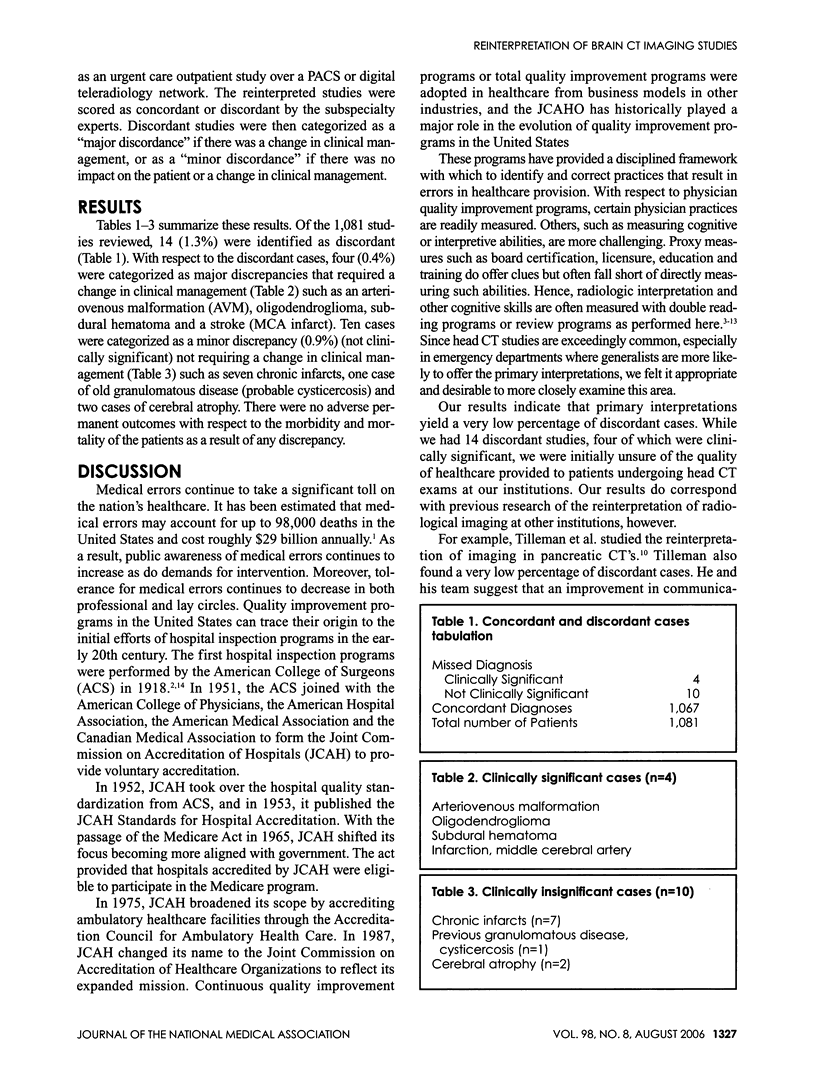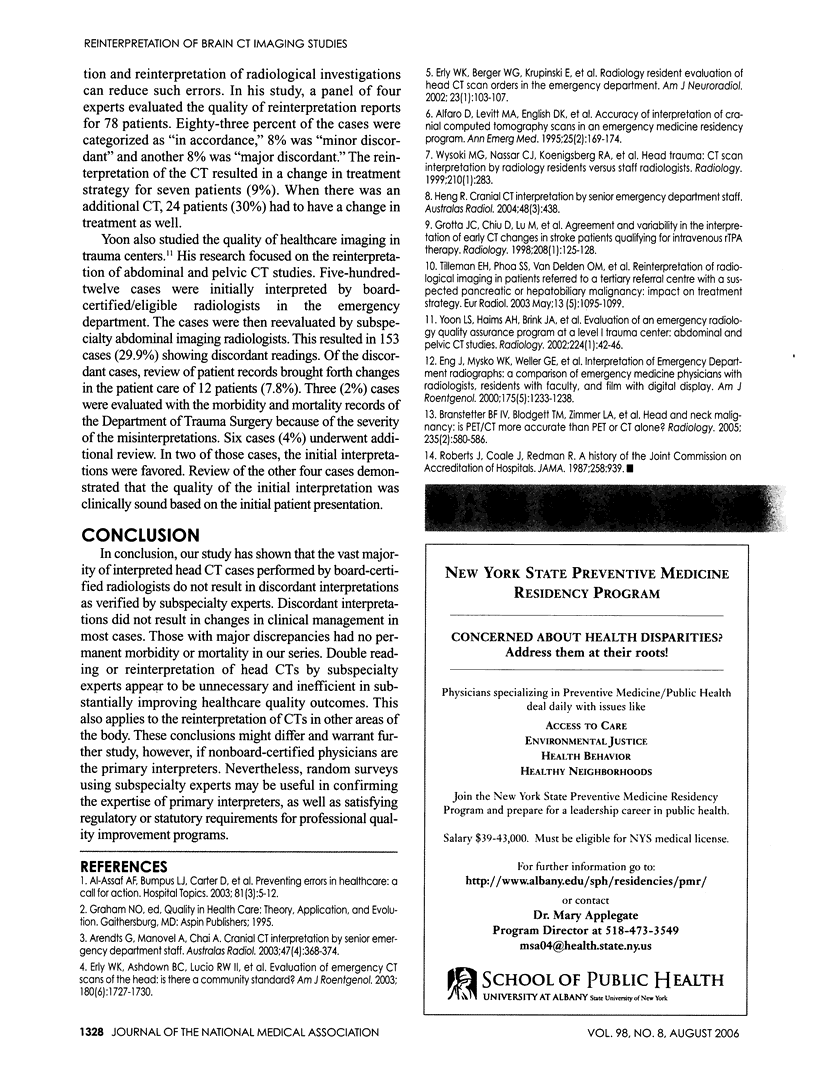Abstract
PURPOSE: To determine the clinical importance and relative value of reinterpreting brain CT imaging studies by subspecialty experts regarding changes in clinical management. METHODS: Computerized records were queried at two institutions during the years 2002-2003 for both primary interpretation by board-certified nonneuroradiologists and secondary interpretation by three neuroradiologists. A total of 1,081 cases were reviewed. Each case was initially interpreted as an emergent or urgent study. The reinterpreted studies were scored as concordant or discordant by the subspecialty experts. The discordant studies were then categorized as a "major discordance" if there was a change in clinical management, or as a "minor discordance" if there was no impact or change in clinical management. RESULTS: Of the 1,081 studies reviewed, 14 studies were identified as discordant (1.3%). Of those discordant studies, four were categorized as major discrepancies necessitating a change in clinical management (0.4 %). Ten were categorized as minor discrepancies (0.9%). There were no permanent adverse outcomes with respect to morbidity and mortality as a result of any discrepancy. CONCLUSION: The vast majority of interpreted head CT cases read by board-certified general radiologists do not result in discordant interpretations as verified by subspecialty experts. Discordant interpretations did not result in changes in clinical management in most cases. Double reading of head CTs by subspecialty experts appears to be an inefficient method of substantially improving imaging health quality outcomes.
Full text
PDF


Selected References
These references are in PubMed. This may not be the complete list of references from this article.
- Al-Assaf Al F., Bumpus Lisa J., Carter Dana, Dixon Stephen B. Preventing errors in healthcare: a call for action. Hosp Top. 2003 Summer;81(3):5–12. doi: 10.1080/00185860309598022. [DOI] [PubMed] [Google Scholar]
- Alfaro D., Levitt M. A., English D. K., Williams V., Eisenberg R. Accuracy of interpretation of cranial computed tomography scans in an emergency medicine residency program. Ann Emerg Med. 1995 Feb;25(2):169–174. doi: 10.1016/s0196-0644(95)70319-5. [DOI] [PubMed] [Google Scholar]
- Arendts Glenn, Manovel Alvaro, Chai Alan. Cranial CT interpretation by senior emergency department staff. Australas Radiol. 2003 Dec;47(4):368–374. doi: 10.1046/j.1440-1673.2003.01204.x. [DOI] [PubMed] [Google Scholar]
- Branstetter Barton F., 4th, Blodgett Todd M., Zimmer Lee A., Snyderman Carl H., Johnson Jonas T., Raman Subha, Meltzer Carolyn C. Head and neck malignancy: is PET/CT more accurate than PET or CT alone? Radiology. 2005 May;235(2):580–586. doi: 10.1148/radiol.2352040134. [DOI] [PubMed] [Google Scholar]
- Eng J., Mysko W. K., Weller G. E., Renard R., Gitlin J. N., Bluemke D. A., Magid D., Kelen G. D., Scott W. W., Jr Interpretation of Emergency Department radiographs: a comparison of emergency medicine physicians with radiologists, residents with faculty, and film with digital display. AJR Am J Roentgenol. 2000 Nov;175(5):1233–1238. doi: 10.2214/ajr.175.5.1751233. [DOI] [PubMed] [Google Scholar]
- Erly William K., Berger William G., Krupinski Elizabeth, Seeger Joachim F., Guisto John A. Radiology resident evaluation of head CT scan orders in the emergency department. AJNR Am J Neuroradiol. 2002 Jan;23(1):103–107. [PMC free article] [PubMed] [Google Scholar]
- Heng R. RE: Cranial CT interpretation by senior emergency department staff. Australas Radiol. 2004 Sep;48(3):438–438. doi: 10.1111/j.0004-8461.2004.01340.x. [DOI] [PubMed] [Google Scholar]
- Tilleman Esther H. B. M., Phoa Saffire S. K. S., Van Delden Otto M., Rauws Erik A. J., van Gulik Thomas M., Laméris Johan S., Gouma Dirk J. Reinterpretation of radiological imaging in patients referred to a tertiary referral centre with a suspected pancreatic or hepatobiliary malignancy: impact on treatment strategy. Eur Radiol. 2002 Aug 15;13(5):1095–1099. doi: 10.1007/s00330-002-1579-8. [DOI] [PubMed] [Google Scholar]
- Wysoki M. G., Nassar C. J., Koenigsberg R. A., Novelline R. A., Faro S. H., Faerber E. N. Head trauma: CT scan interpretation by radiology residents versus staff radiologists. Radiology. 1998 Jul;208(1):125–128. doi: 10.1148/radiology.208.1.9646802. [DOI] [PubMed] [Google Scholar]
- Wysoki M. Trauma head CT interpretation by radiology residents versus staff radiologists. Radiology. 1999 Jan;210(1):283–283. doi: 10.1148/radiology.210.1.r99ja59283. [DOI] [PubMed] [Google Scholar]
- Yoon Luke S., Haims Andrew H., Brink James A., Rabinovici Reuven, Forman Howard P. Evaluation of an emergency radiology quality assurance program at a level I trauma center: abdominal and pelvic CT studies. Radiology. 2002 Jul;224(1):42–46. doi: 10.1148/radiol.2241011470. [DOI] [PubMed] [Google Scholar]


